 |
surfresearch.com.au
surfing
images : 1788 to 1850 |
| home | catalogue | history | references | appendix |
|
surfing images : 1788 to 1870.
|
|
|
|
|
|
In many cases the
images were printed in a number of editions and various subsequent publications
and they are sometimes cropped or resized and appear with different captions.
This is particually
the case in modern printings, see Finney
and Houston (1966) et. al.
It is often difficult to determine the location (which may not be the same as the accompanying report) and whether the image is constructed from the artist's personal observation or a reconstruction based on eyewitness reports.
Images of surfriding
were of varving quality and accuracy - most artists struggled with presenting
the essential dynamics of the activity.
This is most commonly
seen in the difficutly of locating the board and rider in a realistic position
on the wave face.
Bolton
noted in 1891 ... "Some pictures ... represent the surf-riders
on the seaward slope of the wave, in positions which are incompatible with
the results."
In some examples,
a realistic representation is unlikely, given that the artist had probably
not actually witnessed surf-riding and was constructing their image from
a published text, field notes, sketches and/or verbal input.
For example, see
Bayard (1873) and Riou (1873), below.
The second in particular,
has some significant inconsistancies.
In images that were
probably drawn from personal observation, some allowance must be made for
a failure to comprehend the dynamics of wave-riding.
The riding (compared
with the paddle-out) was rapid, the nature of the wave changed dramatically
and it did not resemble contemporary Western activites.
These difficulties
were circumvented with the development of surf photography, which would
play a major part in the spread and evolution of surf-riding.
Most of the early
images have some common features ...
- surf-riding is
represented as a community activity.
- the riders adopt
a variety of riding positions and significantly they illustrate stance
- a feature not noted in the early written accounts.
- the artist makes
a significant attempt to accuately portray the wave shape and action and
there is often an indication that the activity is in off-shore conditions
- considered best by surf-riders.
- in most cases
the wave size is less than six foot and board length is less than seven
foot.
This is probably
a result of observing a large number of riders close to shore.
In some instances,
other riders are located much further from shore than the central figures,
probably indicating they were riding larger waves and possibly with larger
boards.
Some images feature
bare female breasts, undoubtedly of interest to 19th century readers.
Generally, the more
this feature is detailed then the less informative the illustration.
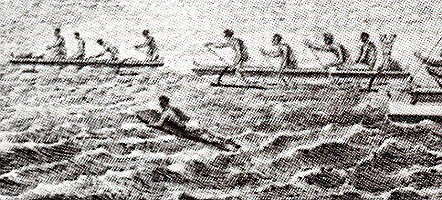 |
First drawing of a surfboard, circa 1778. Detail from ... "A View of KaraKakooa, in Owyhee." Cropped from Finney and Houston (1966) Page 12 First image of surf board. |
Cropped from Finney
and Houston (1966) Page 12
Various resized
and/or cropped versions are also printed in
Finney
and Houston (1966)
Plate 1. A particually poorly printed version, unlike the rest of the book.
| Margan and Finney (1971) Pages 20 - 21. | Lueras (1984) Pages 44 - 45 and 47 |
| Nat's History (1983) Page 33. | Kampion (1997) Page 32. |
| DelaVega (ed, 2004) Page 15. |
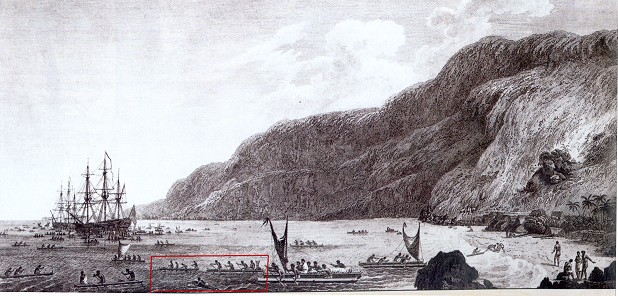
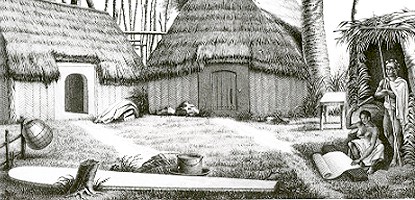 |
or Alphonse Pellion ? : "The Houses of Kraimokou, circa 1819." Finney and Houston (1996) Page 37.. First image of an Olo board. |
A wonderfully detailed
ilustration of Hawaiian dwellings, with the chief in ceremonial dress and
his wife beating tapa cloth. Like all the other early images, she is bare
breasted.
The large Olo board
takes a central position in the drawing and presumably a similar culutural
position.
'' The artwork
from Freycinet's circumnavigation on the Uranie includes original drawings
taken 'd'aprés nature' by Arago, Taunay and Pellion on the voyage.''
http://www.liswa.wa.gov.au/freycinet/pages/campperon.html
"The collection
of drawings which Captain Freycinet has brought home from his voyage round
the world . . . affords the strongest proof of the unwearied zeal and remarkable
intelligence of M. Arago, the draftsman to the expedition"
- from the introduction to Arago ? by Forbes.
(p. xxvi). Borba
de Moraes I, p. 44. Brunet I, 372. Ferguson 885. Forbes I, 562. NMMC I,
154. Sabin 1865. BT000064.
Items featured
in the Freycinet Collection
http://www.liswa.wa.gov.au/freycinet/pages/items.html
Vice-admiral Alphonse
Odet-Pellion
http://www.netmarine.net/tradi/celebres/odetpellion/index.htm
French, available in translation by google.com
First printed in
Freycinet, L :
Voyage autour du mode ... 1817 - 1820. (Voyage around the world ...
1817 - 1820.)
Chez Pillet aine,
Paris. 1825,
Volume 2, Part 2,
Book 4, Chapter XXVII, Pages 517 to 622 (?).
Dela
Vega (ed, 2004) page 20.
Also
Arago, J : Narrative
of a Voyage round the World, in the Uranie and Physicienne Corvettes,
Commanded by
Captain Freycinet, During the Years 1817, 1818, 1819, and 1820.
Treuttel and Wurtz,
Treuttel, Jun. and Richter. London. 1823.
. . . With Twenty-Six
Engravings . . . . :
Folding frontispiece
map and twenty-five lithographed plates after Arago.
Also
Arago, J : Recollections
of a Blind Man
Cited by Finney
and Houston (1996) Page 38.
For an early copy
of the image (credited Alphonse Pellion), see
http://www.hawaii.edu/lruby/hon291/hon291.htm
Scanned from Finney
and Houston (1996) Page 37.
Various resized
and/or cropped versions are also printed in
| Finney and Houston (1966) Plate 12. | Finney and Houston (1996) Page 37. |
| Margan and Finney (1971) Page 19 | Dela Vega (ed, 2004) page 20. |
| Nat's History (1983) Page 33 (badly cropped) | Lueras (1984) Page 35. Colourised, see below. |
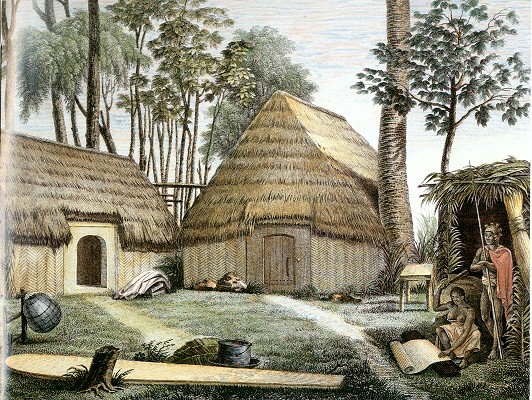 |
or Alphonse Pellion ? : "The Houses of Kraimokou, circa 1819." Lueras
(1984) Page 35.
First image of an Olo board. The sheen on the left hand side is a scanner imperfection. |
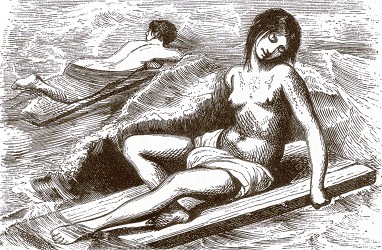 |
"Wahine, Hawaii, circa 1819." Finney
and Houston (1996) Page 38.
Decorative, rather than informative. |
The fascination with the naked female breast can be, perhaps, assessed by a desciption of a young aboriginal woman by Watkin Tench, a British Army officer posted to the initial occupation of Australia at Sydney Cove in 1788 ... "She excelled in beauty all their females I ever saw.
Scanned from Finney
and Houston (1996) Page 38.
Various resized
and/or cropped versions are also printed in
Finney
and Houston (1966) Page 43, Figure 5.
Margan
and Finney (1971) Page 19.
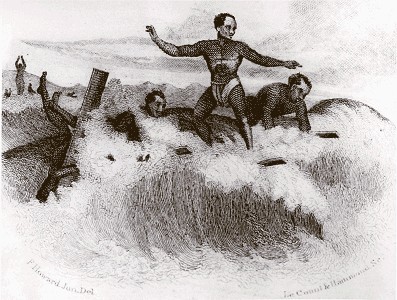 |
"Sandwich Island Surf-riders, circa 1830." Finney and Houston (1996) Frontpiece. The first reported
Western image of surf-riding,
|
Scanned from Finney
and Houston (1996) Frontpiece.
Various resized
and/or cropped versions are also printed in
Finney
and Houston (1966) Plate 10.
George
(1990) Page 21.
Dela
Vega (ed, 2004) Pages 18 -19.
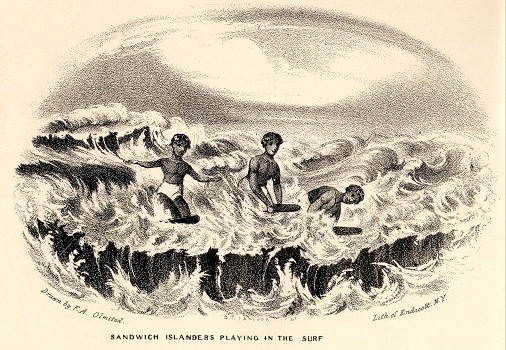 |
"Sandwich Islanders Playing in the Surf, circa 1841." .Lueras (1984) Page 39. First image by the
same writer
|
Scanned from Lueras
(1984) Page 39.
Various resized
and/or cropped versions are also printed in
Nat's History
(1983) Page 33
Dela
Vega (ed, 2004) page 24.
|
|
|
|
|
|
|
|
|
|
|

| home | catalogue | history | references | appendix |